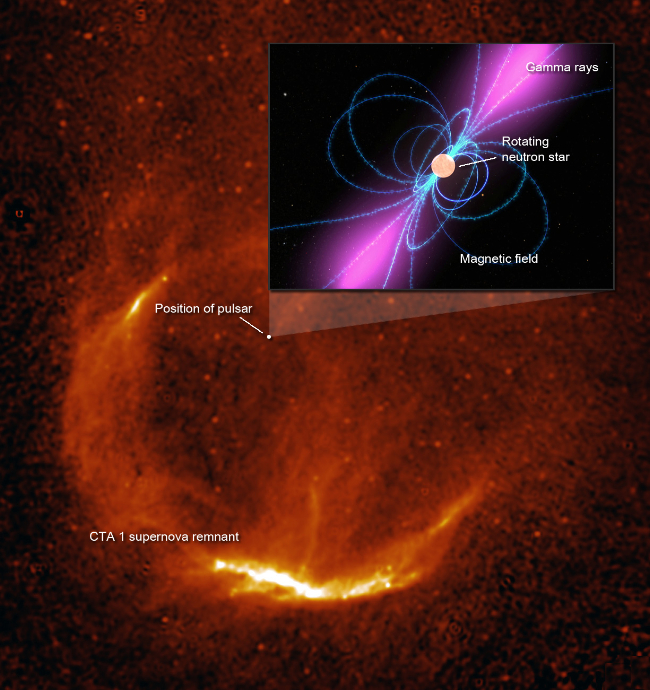
 Credit:NASA/S. Pineault, DRAO
Credit:NASA/S. Pineault, DRAO
New Pulsar
A dying star collapses and a nugget of condensed matter called a neutron star is left behind amidst the debris. Finding this nugget is important since it tells alot about how dying stars die. Radio observations had revealed an extended nebula called CTA 1 which astronomers recognized as the supernova remnant produced when a dead star exploded. X-ray observations showed a source near the center of the remnant. This source is bright in X-rays but optically faint, characteristics appropriate for a neutron star. Observations with the Chandra X-ray observatory showed that this source is associated with a small nebula which surrounds it and a tail of X-ray emitting gas extending from its surface. But pulsations, which can be used to determine the rotation period of the object and to help confirm that it is a neutron star, were never found in radio or X-ray studies. But new observations with the Fermi Gamma-Ray Space Telescope revealed pulsations in this object's gamma-ray emission - the first time a neutron star pulsar has been seen only in gamma-rays. The image above shows CTA 1 and the location of the X-ray source; the inset shows an artist rendition of the pulsar, its magnetic field and the gamma-ray beam originating from its magnetic poles. Scientists speculate that the object's radio beams are rather narrow and don't intersect the earth when the pulsar rotates, but that the gamma-ray beam is wider and shines on the earth once each rotation. How many new pulsars will Fermi find? Time will tell.
Published: October 20, 2008
<
HEA Dictionary ● Archive
● Search HEAPOW
● Other Languages
● HEAPOW on Facebook
● Download all Images
● Education ● HEAD
>
Each week the HEASARC
brings you new, exciting and beautiful images from X-ray and Gamma ray
astronomy. Check back each week and be sure to check out the HEAPOW archive!
Page Author: Dr. Michael F. Corcoran
Last modified Monday, 26-Feb-2024 17:21:04 EST


